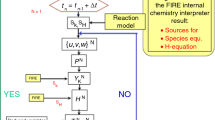Abstract
Different approaches have been proposed to improve the combustion process and decrease pollutants in internal combustion engines. Among them, more attention has been paid to the use of the homogeneous charge compression ignition (HCCI) concept. The benefits of this combustion concept are the simultaneous reduction of fuel consumption, nitrogen oxides (NOx) and soot emission together with thermal efficiency improvement. However, there are still tough challenges in the successful operating of HCCI engines, such as controlling the combustion phasing, extending the operating rang, and high unburned hydrocarbon and CO emissions. In this study, experimental work were performed on a single cylinder engine and the simulation results were compared to the experimental data. The comparison showed the numerical data had a good agreement with experimental data. By increasing the ratio of reformer gas, the maximum pressure and maximum pressure rise rate are significantly increased. Keeping the air-fuel ratio constant and increasing the ratio of the reformer gas reduce the IMEP and heat efficiency, also increasing reformer gas blend fraction decreased HC and increased CO emissions considerably. In addition, using reformer gas expands the operating range lean limit and increases the possibility of engine well operation in this region.













Similar content being viewed by others
Abbreviations
- RG 75/25:
-
Reformer gas with 75% H2 and 25% CO
- RG 50/50:
-
Reformer gas with 50% H2 and 50% CO
- CO 2, up :
-
CO2 volume fraction in upstream
- CO 2, down :
-
CO2 volume fraction in downstream
- CD:
-
Combustion duration in CAD
- CAD:
-
Crank angle degree
- SOC:
-
Start of combustion (CAD, aTDC)
- TDC:
-
Top dead center
- IMEP:
-
Indicated mean effective pressure
- BSFC:
-
Brake specific fuel consumption
- EGR:
-
Exhaust gas recirculation
- λ:
-
Air/fuel ratio relative to stoichiometric air/fuel ratio
References
Mage D (1996) Urban air pollution in mega cities of the world. Atmos Environ 30(5):681–686
Zhao F, Asmus TW, Assanis DN, Dec JE, Eng JA, and Najt PM (2003) Homogeneous charge compression ignition (HCCI) Engines. SAE Publication PT-94
Shahbakhti M (2009) Modeling and experimental study of an HCCI engine for combustion timing control. University of Alberta, PhD Thesis
Hosseini V, Checkel MD (2006) Using reformer gas to enhance HCCI combustion of CNG in a CFR engine. SAE Paper 2006-01-3247
Jamal Y, Wyszynski ML (1994) On-board generation of hydrogen-rich gaseous fuels a review. Int J Hydrog Energy 19(7):557–572
Assad MS, Penyazkov OG (2010) Distinctive features of operation of an internal combustion engine running on hydrogen-containing fuels. J Eng Phys Thermophys 83(4):869–875
Shudo T, Ono Y, Takahashi T (2002) Influence of hydrogen and carbon monoxide on HCCI combustion of dimethyl ether. SAE Paper 2002- 01-2828
Shudo T, Ono Y (2002) HCCI Combustion of hydrogen, carbon monoxide and dimethyl ether. SAE paper 2002-01-0112
Shudo T, Takahashi T (2004) Influence of reformed gas composition on HCCI combustion of onboard methanol-reformed gases. SAE paper, 2004-01-1908
Zheng Z, Liu C, Zhang X (2014) Numerical study of effects of reformed exhaust gas recirculation (REGR) on dimethyl ether HCCI combustion. Int J Hydrog Energy 39:8106–8117
Peucheret S, Wyszynski ML, Lehrle RS, Golunski S, Xuc H (2005) Use of catalytic reforming to aid natural gas HCCI combustion in engines: experimental and modelling results of open-loop fuel reforming. Int J Hydrog Energy 30:1583–1594
Peucheret S, Wyszynski ML (2004) Exhaust gas reforming of methane to aid natural gas HCCI combustion: experimental results of open loop hydrogen production and basic thermodynamic analysis. 7th biennial conference on engineering systems design and analysis, Manchester, UK, pp 453–460
Tsolakis A, Megaritis A (2005) Partially premixed charge compression ignition engine with on-board H2 production by exhaust gas fuel reforming of diesel and biodiesel. Int J Hydrog Energy 30:731–745
Hosseini V, Neill WS, Checkel MD (2009) Controlling n-heptane HCCI combustion with partial reforming: experimental results and modeling analysis. J Eng Gas Turbines Power 131(5):052801
Voshtani S, Reyhanian M, Ehteram M, Hosseini V (2014) Investigating various effects of reformer gas enrichment on a natural gas-fueled HCCI combustion engine. Int J Hydrog Energy 39:19799–19809
Neshat E, Khoshbakhti Saray R, Parsa S (2017) Numerical analysis of the effects of reformer gas on supercharged n-heptane HCCI combustion. Fuel 200:488–498
Rahnama P, Paykani A, Bordbar V, Reitz RD (2017) A numerical study of the effects of reformer gas composition on the combustion and emission characteristics of a natural gas/diesel RCCI engine enriched with reformer gas. Fuel 209:742–753
Zhang Z, Xie Q, Liang J, Li G (2017) Numerical study of combustion characteristics of a natural gas HCCI engine with closed loop exhaust-gas fuel reforming. Appl Therm Eng 119:430–437
Colin O, Benkenida A (2004) The 3-zones extended coherent flame model (ECFM3Z) for computing premixed/diffusion combustion. Oil Gas Sci Technol 59:593–609
Schmidt M (2008) The Sankey diagram in energy and material flow management. J Ind Ecol 12:82–94
Author information
Authors and Affiliations
Corresponding author
Additional information
Publisher’s Note
Springer Nature remains neutral with regard to jurisdictional claims in published maps and institutional affiliations.
Rights and permissions
About this article
Cite this article
Pourfallah, M., Armin, M. An experimental and numerical study of the effects of reformer gas (H2 and CO) enrichment on the natural gas homogeneous charge compression ignition (HCCI) engine. Heat Mass Transfer 55, 1947–1957 (2019). https://doi.org/10.1007/s00231-018-2479-z
Received:
Accepted:
Published:
Issue Date:
DOI: https://doi.org/10.1007/s00231-018-2479-z




